Personal open access report with one click

Which of my scientific publications are openly accessible? As of now, researchers in Switzerland can find the answer to this question by using the "SNSF Open Access Check" web application. This prototype searches articles that have been published since 2015.
The source databases of the "SNSF Open Access Check" are "Dimensions" and "Unpaywall". "Dimensions" lists over 100 million publications, while "Unpaywall" provides the open access (OA) status of over 25 million publications. By combining the two databases, researchers gain access to information that has received little attention until now: the personal OA publication log. The SNSF hopes that the tool will further promote open access publications.
Using the application is simple. Researchers enter their name and the tool generates their own personal OA report. It lists all articles found, attributing each to an open access category (see box). This allows researchers to check at a glance which of their publications are openly accessible and which are not. The tool searches for articles published since 2015, irrespective of whether the research or the publications were SNSF-funded.
Green road underused
There are indications that researchers could use the so-called green road to make many articles publicly accessible that are currently behind a paywall. This mode of publication consists of an initial publication in a fee-charging journal, but after a pre-defined embargo period, the article can be uploaded to a public repository. Many researchers are not aware of this mechanism or forget to make use of it. The list generated by the web application helps to identify articles that could be made accessible in this way.
Limited to articles
Inevitably, the two databases have certain gaps and shortcomings. It is a complex task to generate an automated publication list, attribute publications to authors and verify the OA status. In addition, the data is not equally comprehensive for all disciplines. These limitations concern especially books and book chapters. For this reason, the prototype of the new web application only searches for articles in journals.
Plans for global roll-out
The "SNSF Open Access Check" web application is the first collaboration between the SNSF and Digital Science, the company running the "Dimensions" platform. Together they are now gathering information on the demand for individual OA reports and on their uses and limitations. The aim: make the personal OA status part of the publicly accessible version of "Dimensions". This would expand the pool of potential users to researchers all over the world.
"Verify your own status"
The SNSF requires the researchers it funds to publish their work in openly accessible ways. Thanks to publication grants and guidelines, it is easy to fulfil this requirement. "By creating the new web application, we further strengthen our support," says Matthias Egger, President of the National Research Council. "I'm asking all researchers in Switzerland to verify their own status and make as many publications as possible openly accessible."
OA colour theory
There are different types of open access. The "SNSF Open Access Check" web application uses the following categories:
- Gold: immediately available in OA-only journal, usually accompanied by a fee paid by the author
- Green: accessible in a public repository as a second publication, often after an embargo period
- Hybrid: immediately available in otherwise closed journal, in return for a fee paid by the author
- Other forms of open access
National contracts simplify OA in hybrid journals
As part of the Swiss Open Access Strategy, swissuniversities is negotiating agreements with publishing houses according to the "Read & Publish" model. With the agreements in place, researchers will be able to publish open-access articles in most journals without an additional fee, and to meet the OA requirements of the SNSF. In May 2020, swissuniversities was able to finalise the first agreement with Elsevier.